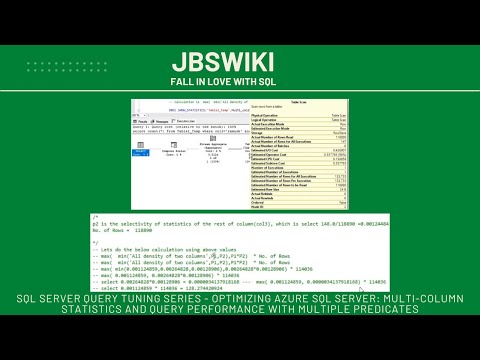filmov
tv
Leveraging SQL Server Computed Columns: Selecting from Another Table

Показать описание
Summary: Explore how to use SQL Server computed columns by selecting data from another table, enhancing query performance, and optimizing database design.
---
Leveraging SQL Server Computed Columns: Selecting from Another Table
SQL Server provides a robust capability known as computed columns. Computed columns are virtual columns within a table whose values are calculated based on expressions involving other columns within the same table. This powerful tool can boost the efficiency of your database queries and improve overall performance.
What are Computed Columns?
A computed column is a special type of column in SQL Server. Unlike regular columns that store raw data, a computed column generates its value based on a formula or expression that often involves other columns in the same table. The calculation can be as simple as a mathematical expression or as complicated as a user-defined function.
For example:
[[See Video to Reveal this Text or Code Snippet]]
In this scenario, FullName is a computed column, dynamically combining FirstName and LastName.
Selecting Data from Another Table
A commonly asked question is whether computed columns can select data from other tables. While a computed column can reference columns from its own table, directly referencing another table is not inherently supported in a computed column's definition. However, you can achieve similar functionality using a combination of computed columns and additional mechanisms like triggers.
Calculated using UDFs
One workaround to incorporate values from another table is through user-defined functions (UDFs). You can define a scalar UDF that performs a complex calculation or query across multiple tables.
Here's an example:
[[See Video to Reveal this Text or Code Snippet]]
You can then use this UDF in your computed column definition:
[[See Video to Reveal this Text or Code Snippet]]
Triggers
For more complex implementations requiring data from another table, triggers can be used. Triggers allow executing a batch of SQL code when a specified event occurs on a table or view. For example, you could use an AFTER INSERT trigger to populate a column in one table based on data from another table.
Benefits
Utilizing computed columns effectively offers several benefits:
Performance Improvements: Computed columns can be indexed, improving the performance of queries that frequently access calculated results.
Data Integrity: Ensuring calculated results are always up-to-date without requiring manual recalculations maintains data integrity.
Optimization: Optimal database design can leverage computed columns to simplify complex queries by encapsulating logic within the schema, making sure that everyone accessing the data can benefit from pre-defined calculations.
Conclusion
While directly referencing another table in a SQL Server computed column is not straightforward, you can creatively employ UDFs and triggers to achieve similar results. By understanding and utilizing computed columns, you can enhance the efficiency and performance of your database systems. This approach ensures that complex calculations are consistently performed, making it easier to maintain and optimize your database design.
Happy querying!
---
Leveraging SQL Server Computed Columns: Selecting from Another Table
SQL Server provides a robust capability known as computed columns. Computed columns are virtual columns within a table whose values are calculated based on expressions involving other columns within the same table. This powerful tool can boost the efficiency of your database queries and improve overall performance.
What are Computed Columns?
A computed column is a special type of column in SQL Server. Unlike regular columns that store raw data, a computed column generates its value based on a formula or expression that often involves other columns in the same table. The calculation can be as simple as a mathematical expression or as complicated as a user-defined function.
For example:
[[See Video to Reveal this Text or Code Snippet]]
In this scenario, FullName is a computed column, dynamically combining FirstName and LastName.
Selecting Data from Another Table
A commonly asked question is whether computed columns can select data from other tables. While a computed column can reference columns from its own table, directly referencing another table is not inherently supported in a computed column's definition. However, you can achieve similar functionality using a combination of computed columns and additional mechanisms like triggers.
Calculated using UDFs
One workaround to incorporate values from another table is through user-defined functions (UDFs). You can define a scalar UDF that performs a complex calculation or query across multiple tables.
Here's an example:
[[See Video to Reveal this Text or Code Snippet]]
You can then use this UDF in your computed column definition:
[[See Video to Reveal this Text or Code Snippet]]
Triggers
For more complex implementations requiring data from another table, triggers can be used. Triggers allow executing a batch of SQL code when a specified event occurs on a table or view. For example, you could use an AFTER INSERT trigger to populate a column in one table based on data from another table.
Benefits
Utilizing computed columns effectively offers several benefits:
Performance Improvements: Computed columns can be indexed, improving the performance of queries that frequently access calculated results.
Data Integrity: Ensuring calculated results are always up-to-date without requiring manual recalculations maintains data integrity.
Optimization: Optimal database design can leverage computed columns to simplify complex queries by encapsulating logic within the schema, making sure that everyone accessing the data can benefit from pre-defined calculations.
Conclusion
While directly referencing another table in a SQL Server computed column is not straightforward, you can creatively employ UDFs and triggers to achieve similar results. By understanding and utilizing computed columns, you can enhance the efficiency and performance of your database systems. This approach ensures that complex calculations are consistently performed, making it easier to maintain and optimize your database design.
Happy querying!
 0:01:40
0:01:40
 0:01:00
0:01:00
 0:22:47
0:22:47
 0:00:41
0:00:41
 0:00:00
0:00:00
 1:00:45
1:00:45
 0:10:31
0:10:31
 0:04:06
0:04:06
 0:01:25
0:01:25
 0:03:12
0:03:12
 0:01:23
0:01:23
 0:01:20
0:01:20
 0:00:49
0:00:49
 1:29:31
1:29:31
 0:34:29
0:34:29
 0:01:32
0:01:32
 1:12:08
1:12:08
 0:01:39
0:01:39
 1:23:30
1:23:30
 0:59:11
0:59:11
 1:02:40
1:02:40
 0:01:18
0:01:18
 0:04:44
0:04:44
 0:21:54
0:21:54